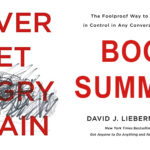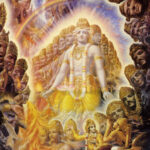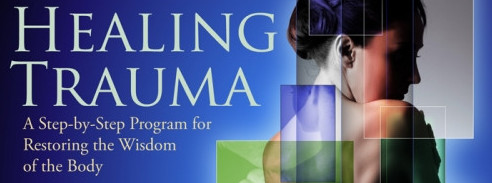
Healing Trauma: A Pioneering Program for Restoring the Wisdom of your Body by Peter Levine (Summary & Video Example)
Animals after escaping prey or trauma do this breathing, sweating and body movements that help them process the trauma and get over it. Humans are seen to do this too with shaking, trembling and body movements. Shamanic healing have the same.
The animals take actions that are exactly the same movement that they would use to complete their escape from the threat.
Neurophysiological mechanisms called kindling. Amigdala associated with fear and terror. So once stimulated it’s locked onto those feeling. A certain kind of stimulation can turn it off as opposed to what experts say.
People who have experienced trauma are dissociated with their body. Loss of connection to body and instinct. If not healed it continues. Your body, shoulders, irritable bowel, migraines could all be connections. No two people are alike, one can experience insomnia, another can get trigged by a door shutting harder than normal. All these people need support and not judgement.
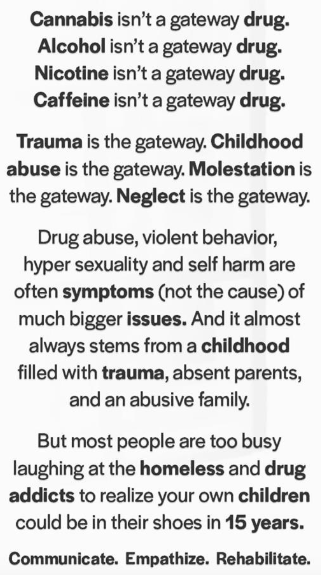
Trauma can range from a vet at war or a child falling off a bike.
People don’t feel the need to be in friendships, they don’t feel as sexual as they used to. Undermining of the self which you don’t share with others. It’s a loss of freedom and vitality. A denial of our potential to fulfil our dreams.
Be aware of the feelings rising up in you. The images and thoughts. There may be emotions but also pay particular attention to sensations. Not so many psychotherapists will use body therapies so you may need to dig deeper to find someone good. The exercises are best done with another person around.
Remember nervousness or anxiousness are an instinctive generation of the body to deal with a threat or perceived threat. Because the mind is used to getting fixated on the scene you have to actively go through it as an observer. The activated reaction can stay on for years until you complete the response so that your nervous system is free.
When we are hyper-alert we are expecting danger. Nightmares, discomfort, dread. We stop that energy so we hold it in. It gives rise to trauma. The survival energy is waiting to be used up. With appropriate guidance the energy can be tapped into and discharged. Feel it in your bodies and let it move through. See Hyper-vigilance for more info.
Some people feel euphoric feeling or high adrenaline arousal. A deep satisfaction comes from completing an arousal cycle. Fixity to flow and from flow to awakening.The feeling of being reborn with a deeper sense of self and deeper understanding of life.
4 Obstacles (Based on Fear)
– Shame: We didn’t fight or escape.
– Energy: Involuntary shaking and trembling make us feel not being in control so we fight it or try to stop it.
– Instinct of Counter Attack: This rage we feel that we need when we want to protect ourselves feels bad or harmful to yourself and others so we cut it off.
– Immobility: It feels like death so we try to stop that too being afraid or death.
This feeling stays in the body and brain and stays in the form of symptoms like hyper-arousal, constriction, dissociation. These feelings can become extreme and the organism tries to find different ways to deal with these energies. Mostly called traumatic re-enactment.
Freud explains that we are always looking for people like our parents to process past issues. Well with trauma its infinitely more powerful and complex. E.g. immobility shock reaction we carry with us everywhere. There is no more danger but our physiology continuously looks for the source of danger. Never feeling safe even with spouses. Our physiology is still locked into this. When we reenact the trauma we repeat it usually putting ourselves in dangerous situations in a way to recreate that trauma in a way to complete it. But the completion has to come internally in our biological process. In our acting out we create further problems. E.g. of animal, cheetah cubs are attacked by lion and they escape. After the lion goes away they reenact the chase and escape for each other. So if we reenact these, we can lose the compulsion to look for it in worse situations. See exercise Wolf/Wild Cat below.
– Exercise Wolf/Wild Cat: Relax and think you’re a predatory animal like a wolf of wild cat. You are in your animal nature, your senses feel the wind, the earth, smells, hear birds, take in surroundings and notice the feeling. Your pups are getting restless from hunger. You pick up a scent. Notice what you feel with you sense the new scent. Have you smelt it before? Is it a meal for your cubs? Notice your body muscles and movement. You notice a rabbit darting across and your body is ready to leap. Feel how your body is ready to pounce and go for the kill. How do you feel in your body and mind, your legs and arms and breathing. Later as you’re resting as your pups eat, feel your breath and notice sensations. Notice any new sensations. Take your time to complete this sensation. This will help you complete the responses that you felt as a prey. Remember to look for those sensations in your daily life too.
A bird caught in hands will have an immobility response will take longer with repeated immobility catches. This fear potentiating immobility will make the traumatised more frustrated and angrier each time. So we need to feel the immobility and embrace it and not let is take over us. See exercise Tourist below.
– Exercise Tourist: You get a call saying you won a trip to safari in Africa. Ticket for 6 friends and you land taken to a great trip. You arrive just at sunset and colours are fantastic. In excitement you ask if you can take a walk while they prepare the fire. You enjoy it so much that you keep going and get lost in the beauty. Observe how you feel. Take it all in, body mind, etc. Now you realise the its become dark and even birds have gone quiet. Notice your heart, breathing, temperature, body. You feel like you need to get back to the camp. Observe what you feel when you hear a loud snap behind you and you look to where it came from. Bushes rustling, it breaks open and baboon coming towards you, observe and take in the startling feeling. It moves towards you snarling. What do you experience? Allow it to go on to completion. Your body turns away from the animal and you start running towards the camp. Feel it all and observe the exhilaration. Now you’ve reached the camp and you feel the fire, smell, relax, etc. Take it and feel it. The fire warms all the immobility out of you and any other stress gets loosened.
Traumatised people fear arousal. So the arousal becomes the enemy. We freeze further even from things that bring us pleasure and enjoyment. We find it hard to enjoy things. Healing the trauma is not only about getting rid of these symptoms, it’s also about accessing the frozen energy and bringing it back into out being to have a full life.
Moving through immobility is like uncoupling from fear. Close your eyes make a fist as tight as you can and then open it and look at your hand. Where did the fist go? Learn to live with the energy and to use it to move forward.
2 important things we can use are our biologies and mythology. Whenever a human need to know something they either go to nature or mythology. E.g. the myth of Medusa. People froze to stone when they look at her. So we don’t want to go head on with dealing with the traumas. Perseus went to the god of wisdom to understand. He used the reflection in the shield to cut her head off. 2 creatures, Pegasus and Chrysaor emerge from her head. The horse is instinct, while the wings on the horse are about enlightenment or and being able to escape the bondage of our limitation. Chryasoar is truth. Perseus collects blood in 2 vials, one will cause death, another life. So we don’t go directly to the trauma, use wisdom, knowledge, instinctual body, etc.
Instincts, emotions and thoughts are usually split off from each other. Renegotiation brings it all together.
Rational brain – thinks, theorises, believes and separates.
Emotional brain – feels, give intensity and colouration.
Instinctive brain – senses, knows and connects.
Exercises:
– Use a pulsing shower head hold it to different parts of your body and say ‘this is my hand, his is the palm of my hand, this is my body’. Then repeat ‘this is the back of my hand, this is my hand, this is part of my body’. This is to awaken the body. If you don’t have a pulsing shower head you just slap or tap the part of your body with your hand and say the same. Keep a portion of your attention on the sensations, thoughts and emotions you are feeling.
– Find a chair and notice how comfortable and how well you settle into it. Notice your breathing and feelings. Imagine today is your birthday. Even through it’s a special day you don’t feel like being lonely so you decide to go to the movies and but while getting ready you feel the dread of losing your wallet. Notice your dread, feelings, where do you feel it, do you feel tightening, sinking, queasy, sweaty palms, tingling, seeing colours and flashes, etc. Anywhere you feel unsteady? Notice how they all change with your attention on them. Do they get more intense or transform? Then you realise maybe you put your wallet in the other room and you start looking for it in place. Still can’t find it and get frantic. Notice body sensations, feelings and thoughts. Slow down and your thoughts get clear. Methodically looking for your wallet, retracing steps. Suddenly phone rings and friend says you left the wallet. Feel the elation, feel your legs walking briskly as you go pick it up, you knock but nobody is opening. You start feeling irritated, notice the range of sensations as before. You hear the muffled voice of friends telling you to come in. It’s dark in the house but you’re fumbling about and can’t find your way. Then as you open the door you hear SURPRISE! You didn’t know it was your birthday surprise. (Write your experience for reference)
– In a chair, close your eyes and imagine taking a lovely hike. Walking to a canyon and getting startled to see the edge of the canyon. How did you feel with you got shocked at a depth of the canyon. Breathing stopped, diaphragm get sucked up, heat flash, high heart rate, exhilaration? What do you feel and allow the sensation to come and settle as you move back and sit on a rock warmed by the sun. Notice if and how they transform. Many people feel them transform like a kaleidoscope. Talk to yourself about what you are feeling. I feel frightened and slowly starting to warm, I’m getting more conscious of my environment, etc.
– Picture grazing impala are being circled by a cheetah unknown to them. Cheetah leaps and is on the move. The impala rush to escape. One separated impala becomes a target and the cheetah is gaining. Allow the experience and move ahead in time to complete the experience. The impala just falls to the ground like it was dead. It’s biology know it was trapped so fleeing was no longer an option. Falling to the ground the cheetah might not kill it but will drag it to a safe area and fetch it’s kids to eat. The impala has a chance to escape because of the immobility reaction.
Symptoms – Categories of Reaction to Trauma
Some are stable and stay a long time, some come and go and others don’t even show up for ages. Things like migraines, asthma, chronic back pain, bowel issues, etc. Before they are healed they may transform to other symptoms. Symptoms should be seen as reminders to pay attention to them and they are wanting completion.
1 – Hyper-arousal: Increased heart rate, sweats, tingling, muscular tension. Increase in thoughts, worrying. If we allow them to have their wave, they’ll peak and dissolve and then we’ll feel trembling, slowing of heart rate, relaxation of muscles, etc.

2 – Constriction: Hyper-arousal is accompanied by constriction and we stay like that without going through completion.
3 – Dissociation: When we face death or that kind of terror, fear and pain. This will trigger us to face it in a way that we don’t feel we are feeling it ourselves. It is the self’s defence.
4 – Helplessness: Immobility or freezing. Helplessness is the break from hyper-arousal. It is being completely immobilised and very different to normal helplessness. This is the freeze reaction instead of fight or flight.
Examples
It’s easier to complete the response when the residue is of a fight or flight variety. The energy is more accessible. Marius Example: Had tendency to anxiety and pain on back and leg. He focused his anxiety and felt a stabbing pain in right leg and back hurting and felt nauseous. He felt the pain was so familiar and pointed it to an event that happened a long time ago. He was attacked by 3 dogs and waking in the arms of a neighbour while father was angry with him. He didn’t like this reaction. His mother had made these new pair of pants made especially for him from polar bear. He felt proud about these pants and talked about them happily. He felt the legs were strong in the pants like the men when they were hunting. This was an archetype that he could work with. He felt the feelings and when he got to the rocks he said he felt like jumping. He picks up a spear and is following the polar bear that only he is going to kill. He stops and aims his spear. He feels the whole experience. The wisdom of his body starts working where the dogs had frozen. Marius is playing the World/Wild Cat exercise. He hit the bear, the men are cutting off bits to make pants. He experiences this feeling. He feels his pants and legs. Tears form as he doesn’t know if he can do it. He shouts in increasing pitch. He cut the belly and fur. Tremors. He feels a little scared but with power and energy. He feels calmer and feels the strength. He got into the activation and then deactivation of the energy. Now he walks back to the village passing where the dogs are. He sees them coming and he feels his legs. Moves to the right and turns, he sees the pole. He feels getting weak. He feels his legs and feels strength coming again. But he feels weak again and gets bitten. He screams and is told to look at the dogs. He brings himself to look at the dogs and as he sees, he sees the dogs have been killed. He didn’t kill them. He sees the electric pole with notches. He climbs and climbs. Now he can see them dead from a distance. He feels like he’s being carried now and he feels safe. His father is very upset, but not mad at him, fathers worried, upset and scared. He was just scared and not that he didn’t love his son. Marius thought his dad was angry at him for messing up, and we are all hard on ourselves the same way. AFTER THIS: Notice in your body where you feel the aliveness and energy and where you feel contracted and stiff. The body and feeling were together. This was renegotiation. Like clenching the fist and allowing it to open and repeating. So the pants were the thread of renegotiation to connect the pleasure and pain. Arousal increased each time but also the resources of the person increased for successful renegotiation.
12 Phase Healing Trauma Program
1. Condensing and Riveting: Going through the experience the person was riveted with the experience and it’s condensed into the bad feeling and all the other good experiences mean nothing. It’s a fixation.
2. Feeling of Defeat: Feeling utterly defeated and no way of recovery.
3. Tracking: Being attune with our inner landscape. Becoming aware of the sensations.
Exercise: Notice what you feel in your body. Shift your attentions that are more positive and notice what happens just by focusing. Gradually shift to less positive and notice. Find your own tempo to go back and forth like a soft slowly moving flashlight. Track different regions to even less positive areas and ask yourself what you’re experiencing now, and now… and now. Notice the movement between.
4. Pendulating: See above exercise about losing keys/wallet and surprise party. To go back and forth between these nervous system polarities.
5. Resourcing: Being able to move back and forth between two states and finding ways to complete the experience. Bring back into your own awareness where you felt comfortable and safe. Or with someone who makes you feels this. So they can come from outside or inside.
6. Uncoupling: Separating and detaching from the experience. Feel the excitement when you move to the positive and notice how the feeling of anxiety changes.
7. Grounding: Centering.
Exercise: Imagine yourself being a tree, branches to the sky, trunk connects you to the ground, the roots going as deep as you are high and taking the nutrition you need and giving you what you need. Now imagine below the ground a magnetic force of gravity pulling you down. The roots down and pushing your trunk and branches high. Suddenly the wind blows hard. Where do you feel the trembling. The wind increases and with the high gust the tree bends to the ground. Shift your attention to the roots. Still stable and deep connection to the earth. Pendulate from the centred-ness to the havoc above. Next time notice how rooted animals are and spend time with them to study them.
8. Resiliency: We can bend so much without breaking. Healing the trauma helps.
Exercise: Play music that makes you feel bouncy. Feel like you’re a tree and when you feel the beat with the bounce, you do the same but feel how steady you are and how your knees are good springs to balance you and propel you off the ground. The body adjusts itself when it comes back down. Notice these.
9. Restoration of (Natural) Aggression: It’s the animal instinct. It helps you get out of immobility, to survive. You can confront what you need to. It empowers you.
Exercise: Imagine walking a country road. You see a few houses and see a dog barking at you and comes towards you but you hold your ground. Feel and notice. Let that dog know you have the right to be there at that time. You stand your ground. Feel the strength and aggression you have.
10. Running Response: As much as natural aggression makes sense. Running makes the most sense in threatening cases. It is another biological instinct.
11. Orientation: You figure out what is around you. Looking for danger, escape, sources of threat, resources, thinks you need to keep on mind. In trauma you only look for sources of threat. When there is a new think in the environment you may get into a higher state of vigilance.
Exercise: Take some time everyday and be conscious of your orienting response. Talk to yourself, now I’m aware of myself tightening, I am aware of the person coming in the train, etc.
12. Completion: Restoration of self-regulation. Getting back to being able to feel all responses positive in situations and experiences. We are free to not have to worry or try and control things or people to feel safe. Sorting and seeing things as they are. It’s not a single event and will never be fully complete but you keep completing parts and able to ask what happens next.
Sexual Trauma
– Exercise – Mountain Meadow: Imagine watching a herd of elk in a mountain meadow or being part of it or both. You could be a calf suckling on mom while the males look out for security. Relaxed in the sun and with the nature. What do you feel especially in your body, where in your body. This is part of the positive vortex. A twig snap, what do you feel? Looking and orienting and then returning to normal as there is not sign of threat. Orienting will be very important especially to find escapes and locating threats. Feel your eyes move around while scanning the scenery. Move them smoothly and very slowly. Notice how your head and neck turn or move up and down or in arcs. Notice where you feel stiff or discomfort. Feel the warmth of the sun at the same time. It lets the nervous system know that danger is not present all the time and that you are able to scan and move if needed. Back to the meadow and back to the body feelings. This time there is a rustling of the bushes, all of the herd stops in unity. Notice what you are doing with your body. As you notice the mountain lion, what does your body feel like? Tension? Heartbeat? Etc. Allow it to settle and allow your experience to pendulate from relaxed in the sun in the positive vortex to the threat and caution. Feel the power of the protective elks and the strength of the mothers. What happens as you stay with this feeling. As this goes on, the lion backs away and returns. Where and what are the sensations you are feeling?
– Exercise Scenario 2: This time the lion comes forward. The male elks go into defence mode. The whole herd prepares, orients and runs in a cloud of dust. Feel that power in the ability to escape in your legs, hips, shoulder etc. How does it feel that you are so capable to get away. Make the movements if needed. Being with other elk climbing up to safety. How does it feel that you’re with your crew. The elk have returned to what they were doing in the new meadow and the lion is gone. Observe the feeling and if possible it’s good to talk to your partner about it.
– Exercise Scenario 3: This time the lion comes out and is even more threatening. The herd gets into the position to defend themselves instead of running. Head down, facing antlers to the threat. Feel in your head and neck and body what it’s like to have the aggressive stance. What does it feel like that you know you belong here. The elk don’t move apart from heads. They’re not going anywhere. How do you feel being ready to fight with your army if necessary. Take your time to feel the power. You will also feel caution and feat. Pendulate between these feelings and group them. The lion backs away. Notice how you feel blending the feeling together and how does that transformed energy feel as it goes through your whole body and moving to your feet until it gets grounded into the earth. Notice your body and notice your feelings. Very slowly rub your fingers together and feel parts of your body as you slowly return to your own body and mind. Repeat until you feel comfortable pushing yourself further.
– Exercise Scenario 4 (Immobility/Death Response): First make sure you are comfortable doing this exercise and that you have enough mental and emotional resources. This time the lion lunges forward. An elk becomes a target and the lion captures one with its teeth around the neck. Feel the sensations and allow them to be there. If you can, become aware in your body where you feel less tense and constricted and less frightened. Now pendulate between the feeling of fear and tension to the feeling of ease and no fear. Take all the time you need until you get it. The lion twists the neck and gets the elk to the ground. As you identify with the elk your body collapses and as you lay there like you were dead. No pain, no fear. You feel nothing. Sense it and know this void. Blank or blackness, whatever it is, just know it and feel it. Feel the death. Looking from the outside you can’t move and can only know the experience. You may still be aware of your heart beating and breath. Know it as part of the death state. The moment the elk surrenders to death, it’s spirit is freed to wonder and soar. Notice what your internal experience is like. Even if it’s mundane feel it. Take your time. After this feel that 2 pieces of that elks existence returns to the body. And then another, and then another. Each breath you take, each piece comes back together. Each breath, particles come together, recognising where they belong and find their right place in the body. The elk rises from the body and begins to shake and tremble as it comes back new, fresh. What is your experience, feel it fully. The lion is no longer there and the elk carry on like nothing went on. Sun shining, elks grazing, wind blowing over the plants.
– In many Eastern and Buddhist traditions 4 gateways are seen to awakening.
1: Years of structured, disciplined meditation.
2: Death. People with near-death experience feel a transformation.
3: Deep sexual ecstasy and not sexual titillation or just sexual release.
4: Trauma. Which really gives us a deep dimension to being which others don’t allow us.
– Trauma and Memory. When we experience it it feels like a true recording but science says we only remember the last memory of the memory we relived. So sometimes we feel the images are real when doing the exercises but could just be symbolic and splitting of the vortexes. The keys is in integrating the polarities weather they are fully accurate or mixed pieces of separate and unrelated events. Healing is the priority. Polarities and dualities exist, without the darkness we can see the beauty of the stars.
– Reenactment: It happens when we can’t heal our traumas. People put themselves in similar situations to heal the trauma but end up creating more and more traumas. It’s behaviour driven by unresolved energy. It’s compounded by the feeling of helplessness. E.g. Prostitutes working in dangerous and violent situations were abused in their childhood so they create self-sabotaging experiences. So they will become a perpetual victim or keep victimising others. But they’re not doing anything to resolve the original trauma.
– Good practices would be to stay with the person and keep the person calm and quiet, give them time to discharge the energy and shock. Let it happen, let them know what they’re experiencing is OK and let them shake it off. Unless it’s an emergency and need attention. Even letting them talk about it be present and help them focus on the feelings and sensations.
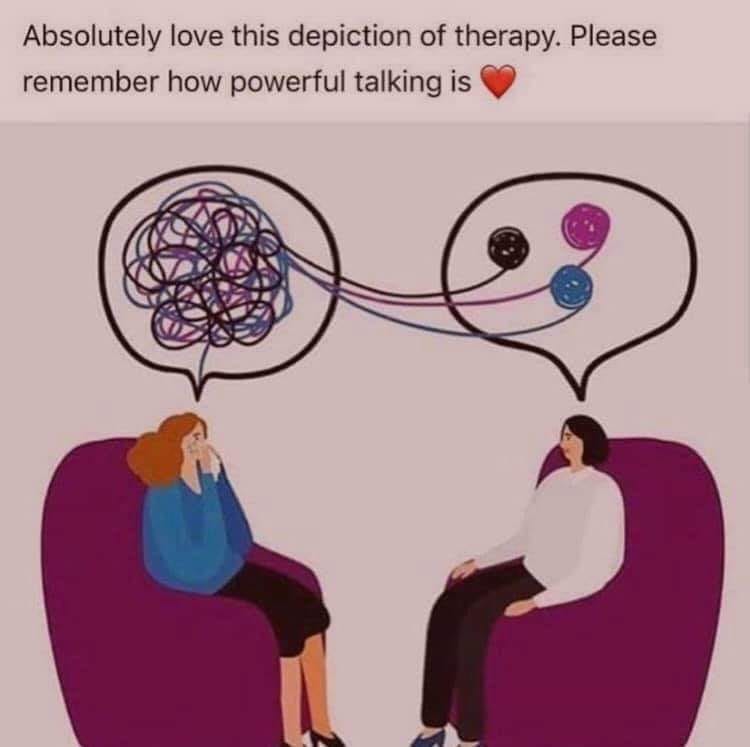
– Accidents and Falls with Children: Tell the child to take a rest and reorient themselves especially if they’re over-emotional or not emotional at all. Support their back with your hand where their heart is but not excessive rocking or petting. Ask what they feel in different parts of their body and wait for response. You could even say that it looks like they feel bad and ask them to point where. What does it feel like, size, shape, colour, weight. If they have reaction just let them know it’s normal and healthy. Look for repetition like smashing toy car into doll. If they show controlling behaviours where they need to control everything. Toilet training issues, hyperactivity, ADD, startling easily, bed-wetting, thrashing in bed. If these things occur in clusters together then keep an eye. Sometimes they grow out of them but sometimes the nervous system has found to hide it so it’s not so obvious.
Contents
Acknowledgements
Introduction: A Tiger Shows The Way
1 – What is Trauma?
2 – The Causes and Symptoms of Trauma
3 – How Trauma Affects the Body
4 – 12 Phase Healing Trauma Program: A Guide to the Audio Exercise
5 – Sexual Trauma: Healing the Sacred Wound
6 – Spirituality & Trauma: Pathway to Awakening
Helpful Tips and Techniques for Preventing Trauma
Additional Resources
About the Author
